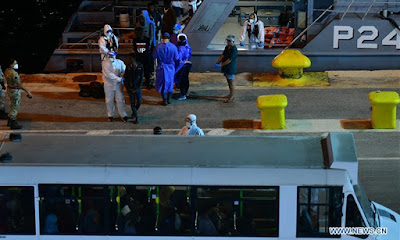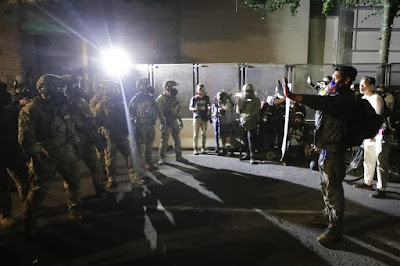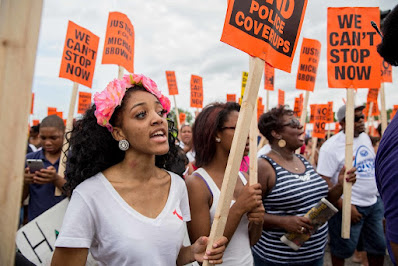A Warning from Wisconsin
Wisconsin sells more paper, employs more people and has more paper mills than any other state. The industry was already in decline, but the coronavirus delivered a death blow.
Verso Corp.'s Wisconsin Rapids Mill is seen across the Wisconsin River on July 27, days before its closure.
By Peter Kendall
Washington Post
JULY 30, 2020
WISCONSIN RAPIDS, Wis. — Darrell Fox checked his email at the paper mill on a summer morning in June and immediately texted his wife at home: “Call me if you’re up.”
He didn’t want to tell her by text that the mill was closing.
They had met at the plant long ago, married and worked there together. Now they were losing their jobs together.
The massive paper mill has churned relentlessly since it began feeding off the energy of the Wisconsin River more than a century ago, forming the cornerstone of a city’s economy and producing glossy paper coveted by publishers during the heyday of U.S. magazines.
But the covid-19 pandemic has sped up a long-term trend — the waning need for the paper used in magazines and printed advertising — and Verso Corp.’s Wisconsin Rapids Mill will finally fall silent at the end of the month. The shutdown, announced June 9, will knock some 900 people out of work and has sent tremors across the region’s economy, reaching from the plant’s gates through town and deep into the Wisconsin forests that supply wood pulp to make paper.
The coronavirus is proving to be a decisive Darwinian force in industries from retail to energy to transportation, culling some businesses that might have been weakening for years while giving others a new jolt of life. The swiftness has been stunning, with each closure in turn affecting other businesses and their workers, as has been playing out already around Wisconsin Rapids.
“It impacts the 900 employees directly in the plant,” said Missy Hughes, secretary and CEO of the Wisconsin Economic Development Corporation. “But the important thing to keep in mind is that the plant purchases and processes 25 percent of the timber coming off of Wisconsin’s land. That impacts the haulers who are bringing the wood to the plant, it impacts the loggers who are cutting down the wood, and then it affects the landowners.
“In Wisconsin, 2.4 million acres of managed forest is owned by counties, and they use the proceeds of the sales to fund their government operations,” Hughes said.
The closure is yet another destabilizing economic event in a state that Donald Trump carried only narrowly in 2016. The mill shutdown will result in the largest permanent layoff in Wisconsin since covid-19 barreled into the economy, according to layoff notices submitted to the state, shocking a county that Trump carried overwhelmingly with nearly 57 percent of the vote.
A local task force is exploring options to save the plant, which the company will continue to maintain in case a buyer emerges. One option being pushed by loggers in the Great Lakes Timber Professionals Association is the formation of a cooperative to put the plant into the hands of the people who feed it and depend upon it.
Cindy Hansen, 51, and Darrell Fox, 47, at their home in Vesper, Wis., on July 28. The two met at the Wisconsin Rapids Mill and have been married for 23 years while continuing to work there.
Known as the Dairy State, Wisconsin is also a paper state. The industry in Wisconsin sells more paper, employs more people and has more paper mills than any other state, according to a 2019 study.
But the paper market, like everything, has been rocked by the novel coronavirus.
When it announced the shutdown, the company cited research that found demand for printing paper fell 38 percent year-over-year in April. The research forecast an even greater plunge to come, with operating rates falling 70 percent in the second quarter.
The trend line for the Wisconsin mill’s paper had been pitched downward long before the pandemic, however.
Katie Mencke, a senior consultant for paper industry researchers and advisers Fisher International, noted that the market for coated paper had been in decline for more than a decade as digital media supplanted print. Covid-19 only accelerated it, though dramatically.
“It was a very sudden stop,” said Mencke, comparing it to the last economic downturn to hammer the paper industry. “With the Great Recession, it was a very slow start.”
She noted some of the ways the coronavirus has eroded demand for magazines: Retail stores have removed them from end caps to reduce “touch points” for shoppers, salons are closed or have discarded them, and flights that haven’t been canceled don’t have airline magazines onboard to keep the planes cleaner.
At the same time, the market for other kinds of paper, such as packaging, is improving. But the costs of retooling the highly specialized machinery in a paper mill is enormous, she said.
In a statement, the company said it explored options for the plant, including converting it to make different paper, but has “been unsuccessful in finding a viable, economical and sustainable alternative.”
“There is so much capital invested in those mills, it is never easy for a company to walk away from that,” said Mencke. “When a company decides to shut something down, it is because it is the best case for the dollars, but it hurts the town and all of these families.”
Downtown Wisconsin Rapids, where the Verso mill's shutdown will affect 900 employees but also send reverberations throughout the local economy.
Looming changes
Many in Wisconsin Rapids can point to where the branches of their family tree are intertwined with the mill. In some cases, multiple family members work there now.
Cindy Hansen graduated from high school in 1987 and was working seasonal jobs at a canning plant and cranberry processor before taking a step up to working at the paper mill.
A few years later, Darrell Fox wore his high school letter jacket to the interviews and physical at the mill just weeks after his 18th birthday. His older brothers worked there, as had his dad, and it was all he had wanted to do.
Cindy trained Darrell when he started his new job, and after the two became good friends, he worked up the courage to ask her out.
Now married for 23 years, they have two sons, a home and land in remote Wisconsin they use as a getaway, all supported by their dual wages at the mill. “We basically could buy what we needed, when we needed it,” said Cindy, 51.
They have now ratcheted back their expectations from moving forward to just not losing what they have. “My goal is to not give anything up — we don’t want to have to sell anything,” said Darrell, 47.
They believe they are more fortunate than most, however, and have been interviewing for other jobs already. But those jobs pay considerably less, casting a shadow over their future retirement.
“We told the boys it is not going to be the same, and we can’t be buying them expensive things anymore,” said Cindy.
“We never spend foolishly, but you didn’t think twice if you wanted something — you could make it work,” said Darrell. “It’s not going to be like that anymore.”
Paper pioneer
The mill sits hard on the banks of the Wisconsin River, white water churning at its feet and white plumes billowing overhead from its tallest stack, about 28 stories up. Rows of logs waiting to be masticated into pulp stretch for nearly a half-mile, looming like the glacial ridges that dot the state.
The plant was once a hub of innovation. In 1904 it was the first to use electricity to power its paper machinery and pioneered making coated, glossy paper cheaper and faster, according to company histories.
The mill long ago boasted that it was the largest manufacturer of paper in the world, and in the 1930s became the sole manufacturer of the stock used to print Life magazine, according to a history produced by the Works Progress Administration in the 1940s.
The company says its list of current customers is confidential.
Many Wisconsin Rapids residents have lived parts of this history.
Rick Armagost is almost literally a product of the mill. His parents met there in the 1950s, with his dad eventually putting in 40 years. “I’ve been a mill rat all my life,” he said.
He joined the Marines after high school in the 1970s, then came back to Wisconsin Rapids and put in his application at the plant. In 1984, he got the call to start.
“That’s where you went to work,” he said. “It’s gotten me everything, on a high school education.”
At 26, the wages were good enough that he was able to buy a 120-acre farm outside of town, where he keeps about 20 head of beef and dairy cows.
Over time, though, he saw his earning power erode. His father had a higher standard of living working at the plant than he does, he said. “He went on a hunting trip and a fishing trip every year. He had a new vehicle every couple years. I have never had a new vehicle.”
He added: “That’s just America now.”
At 60, retirement is still far off. Armagost is discouraged by the thought of going back to school because he thinks his age would further dim his prospects of getting a job by the time he finished.
“I don’t know what I am going to do,” he said starkly. Still, he feels worse for others.
“It is going to be bad for this town,” he said. “It is not just the 900 who work here. It is going to have a trickle-down effect on the whole town.”
Psychological toll
Businesses in Wisconsin Rapids, battered by the economic reaction to covid-19, are already feeling the impact.
Amy Sheide, 50, had already burned through her retirement income to make payroll at Great Expectations, her family’s restaurant and catering company, when the coronavirus struck. Then came the shock that the mill would close.
With only a few more paychecks coming, mill workers are forgoing dinners out and aren’t hosting catered events. What catering business remained amid the pandemic she saw vanish with the mill closing. “There are smaller graduation parties, not holding 50th-anniversary parties, retirement parties that will not take place,” she said.
She and her husband now work every shift at their restaurant. She can afford to schedule her wait staff shifts on only one or two days a month. The kitchen staff has had furloughs.
“Am I in danger of losing my business? Absolutely,” she said.
She worries also about the deeper psychological toll the closing will have on the town.
“It shakes the core of our community,” she said. “And you see a negative attitude — ‘The town is dying; there is nothing there anymore’ — when that is not true.”
The Wisconsin paper industry is a complex economic ecosystem that sprawls along the state’s rivers and reaches deep into its forests. It is populated by multinational corporations on one end, and on the other by independent operators who spend their days in the woods and answer to no one.
Paper was an $18.16 billion Wisconsin industry employing 30,262 workers at 34 mills, plus another 204 facilities that convert that paper into other products, according to a 2019 state study. Factoring in other parts of the supply chain, including loggers and truckers, it grows to $28.88 billion and 95,853 workers.
Those in that supply chain are now feeling the pain of the mill closure.
Logging company operator Laura Delaney was in the middle of a cut when she got word Verso was shutting down. Everything stopped.
“That wood is now just sitting there,” she said. “I can’t sell it.”
Her parents started their logging company in 1972, before she was born. Each winter, when her father would have no work pouring concrete, her parents headed into the woods, Delaney’s mother measuring the logs and her father cutting them with a chain saw.
Eventually, he stopped working construction and turned to logging full-time. Delaney, 41, now runs the business, and her parents are semiretired.
With Verso closed, she has scrambled to find other buyers but has had to shut down her company for a week and a half in both June and July, idling her 10 workers. Shutdowns take a heavy toll on her and others in her business, which typically requires significant debt for heavy equipment.
“It’s not like going to the store and buying a lawn mower,” Delaney said. “We went to the store and bought a machine that can cut this wood to length that is $750,000. A forwarder [to move logs to piles] costs $500,000. An outfitted truck costs $150,000.
“The bank doesn’t say ‘Skip the payment on that thing’ when it is just sitting there,” she said.
She is on the board of the timber association backing the proposal to turn the plant over to a cooperative that would include loggers. She believes the work done by the industry in Wisconsin is essential but overlooked.
“Whether you talk about it or not, we are in your life,” she said. “You know that Amazon carton? I made that cardboard. Have you eaten a Reese’s Peanut Butter Cup this week? Well, sure enough, I made the paper that made those wrappers.”
The plant closing has infused all aspects of local life — including politics, as the presidential election approaches.
“Everyone in Wisconsin Rapids is either going to be related to someone who got laid off or will have some kind of close connection to someone who got laid off,” said John Blakeman, a professor of political science at the University of Wisconsin at Stevens Point. “At a personal level, voters will feel the impact directly or indirectly. That will probably mobilize voters, and it will probably come down to whether they hear the economic message that is meaningful to them and less on identity-based politics.”
From May to June, statewide voter approval for President Trump’s handling of the economy fell 4 percentage points to 50 percent, as voters’ view of the direction of the economy turned down sharply, a Marquette Law School poll found.
The poll also found that a majority of Wisconsin voters disapproved of Trump’s handling of the coronavirus pandemic and the George Floyd protests. Overall, the June poll found 49 percent of voters said they would vote for former vice president Joe Biden compared with 41 percent who supported Trump, Biden’s largest margin in Marquette’s polling this year.
Blakeman noted that in the April primary, Wood County had relatively high turnout and that nearly half, or 49 percent, of voters cast a ballot for a Democratic candidate.
“There is something in the district that has energized Democratic voters, at least in the primary,” Blakeman said. “That is why I am thinking Trump will still carry the county, but his margin will be narrower.”
A task force convened by local elected officials is looking at options to revive the plant once it is mothballed by the company, including finding an outside buyer and converting it to make other kinds of paper.
The state development corporation is studying the viability of a cooperative, which would put operations into the hands of the plant workers, the loggers and the haulers.
“For me that is the most exciting effort,” said the development corporation’s Hughes. “It is an effort to control their own destiny and to have ownership interest where they are ‘it,’ they are the industry.”
That, Hughes said, would allow a long-term, sustainable plan for the plant, “so there is not someone just coming in and selling it for parts or closing it.”
State Rep. Scott Krug (R), one of the officials who launched the task force, called the cooperative proposal “the most intriguing idea out there.”
Krug said state money would be needed, but the work by the forestry industry and others has made him hopeful about the proposal. “They are further along than I thought they would be,” Krug said.
Dennis Schoeneck, 60, is one of those pushing for a cooperative with the timber association. He has worked his whole life in the woods. “I bought my first chain saw when I was 11,” he said.
Looking for a new outlet for his wood after the Verso closing, he was told at one mill that 90 loggers had been there before him.
A passionate proponent of managing forests and of paper as a sustainable resource — “What else should we use, plastic?” he said — he believes the same sustainable approach can save the mill.
“We won’t have any of those big dogs at the top making millions of dollars and not putting it back into the facility,” he said. “We would put it back into the facility.”
In addition to looking for ways to save the mill, the local task force is also exploring how to increase government and charitable aid to the region if their efforts fail.














